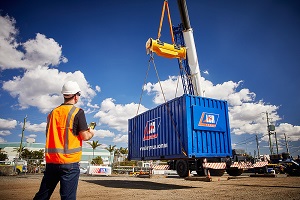Australia’s niche champions: Finding your niche in manufacturing and innovation by Matthew Young

In this part of our Australia’s niche champions series, Dr Matthew Young explains the What? Why? How? and Who? that need to be asked when partnering to find a niche in manufacturing and innovation.
Although I didn’t realise it at the time my personal niche in manufacturing and innovation was found early in my career.
That niche was the ability to bridge the divide between research and practical application in industry, the space IMCRC refers to as “Innovation”, but is often also described as the “Valley of Death” for the many science and engineering discoveries that fail to achieve a commercial outcome.
Working within “The Valley of Death” is not an easy career space in which to “Live Long and Prosper”. There is a fine line to walk between practical experimentation and development to build confidence and repeatability for profitable manufacturing (“r & D”), compared to developing a full fundamental understanding and proof of theories and technologies (“R & d”).
A successful innovator in manufacturing needs to engage with the entire business from day one. Success is predicated on sponsorship and buy-in from leadership all the way “up” to the factory workers.
In industry, the innovator should always be prepared to work as an intermediary between all roles that contribute and may be affected by innovation implementation, such as finance, management, suppliers, system integrators, facilities, tradespeople, maintenance, quality assurance and most importantly work health and safety.

Innovation to find a manufacturing niche plays to the advantage of small and medium businesses (SMEs) as only a handful of people may be involved in the innovation process, allowing agility and fast decision cycles.
Large organisations are often slower to innovate as departments can be siloed and behave independently within their operation and metrics for success which sometimes ignore impacts on other aspects of operations. However, scale allows for larger and longer-term significant technical problems to be addressed.
In my current role as Manufacturing Innovation Manager at IMCRC, I’m working more broadly in this innovation space, helping manufacturers, mostly SMEs, find or expand their niche through collaborative innovation with universities and CSIRO.
To date, of the 32 individual research projects that IMCRC supports, several industry partners fit the dictionary definition of “niche manufacturing and innovation” to a tee. They have found a specialised segment of the market for a particular kind of product or service. For example, projects such as “Novel materials for the next generation of lightning strike protection devices”, “Atmospheric Plasma Coating System”, “Needle Free Vaccination” or “Remote controlled load management”, all have the potential to create new business or disrupt the traditional market.

However, for most IMCRC projects the industries and outcomes supported by innovation are trying to carve out an advantage or opportunity that will differentiate and provide a “niche” in already established marketplaces and supply chains, exampled by manufactured devices for “Smart” Civil and Building Infrastructure, Just in time patient specific 3D printed implants, Robotics for Custom Manufacture or value adding to Australians mineral resources for Lithium refinery waste streams or Purification of Alumina for batteries, sapphire glass and LED’s.
IMCRC, in funding all projects, asks significant questions to help establish whether the innovation planned will support the business to better fill its niche. Although there are many questions in the application, I believe, it is important for all manufacturers to consider the following four key points of What? Why? How? and Who? when partnering to find a niche in manufacturing and innovation:
1. What is the problem / gap / opportunity within the Australian manufacturing industry that innovation can solve / fill / create?
Having a well thought out “What?” statement that is succinct and convergent in its focus is required, as this will unite those working to innovate towards clear and common objectives.
2. What will be the primary manufacturing outcome(s) for the business, and how will it solve the problem / fill the gap / create the opportunity?
It must be clear “Why?” this innovation is important to the business, and that if successful it will enhance operations. Manufacturers need to understand the benefits to the business, the pathways to markets, the return on investment and the global access and export opportunities. These are all factors that lead to a greater growth potential.
3. What will be the intended milestones and deliverables? What advanced technologies, collaborations and approaches will be used to solve the problem / fill the gap / create the opportunity?
A well thought out plan of “How?” is needed, which also provides a clear understanding of risks and mitigations. It needs to be “live”, allowing flexibility in its approach when issues arise, or risks, are realised. This plan should continually consider how technology and digital transformation can be integrated into innovation and the business to increase returns, improve robustness and gain or maintain a competitive advantage.
4. Finally, and possibly the most important piece of the puzzle for finding your niche, is finding the “Who?”.
People are always important, especially in innovation. I would encourage all to look for and engage to innovate with those who have strong skill sets, track records and are a cultural fit to your business. Businesses leaders should consider if teaming with another company they normally consider competition could create scale and access to new markets both locally and globally. Who outside your business is a critical and suitable partner for success including suppliers and customers? Always look for companies and individuals that can be engaged in your innovation process, willing to contribute and have “skin in the game”, because they see value to their business or personal growth through the outcomes of solving the problem / filling the gap / or creating the new opportunity.
With the right approach and supported by those passionate about innovation, manufacturers can bridge the Valley of Death. Key is to find the right people or organisations and empower them in their tasks to deliver impactful change and success.
Dr Matthew Young is Manufacturing Innovation Manager at the Innovative Manufacturing Cooperative Research Centre.
@AuManufacturing’s Australia’s niche champions series is brought to you with the support of the Innovative Manufacturing Cooperative Research Centre, and SMC Corporation.


Subscribe to our free @AuManufacturing newsletter here.
@aumanufacturing Sections
Analysis and Commentary Awards Defence Manufacturing News Podcast Technology Videos










